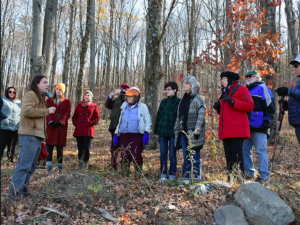I’ve been teaching in the outdoor space since I was a teenager. I decided after being a student teacher for a year that classroom teaching was not my path. There was something about being constrained by the walls.
Justin Wexler created Wild Hudson Valley in 2013 after completing his Master of Arts in Teaching at Bard College. Over the past 8 years, he and Wild Hudson Valley have worked with environmental organizations like the Columbia Land Conservancy, various nature preserves, and historical societies.
Through Wild Hudson Valley, Justin leads upwards of 20 nature walks per year, depending on the year. Guiding people through the forest, Justin points out native medicinal plants, strategies to remove invasive and non-native species, and even some indigenous hunting customs and ancient folklore.
In 2014, Justin joined his partner, Anna, in managing a large-scale agroforestry project known as the American Ginseng Pharm. They’ve planted 250 acres of ginseng, making it the largest wild-simulated ginseng farm in the world. They also grow a wide range of rare, native heirloom fruit- and nut-bearing trees like American Plum and Black Walnut.
From a young age, Justin was curious about indigenous culture:
When I was 8 or 9, it dawned on me that the people who would know the most about the land, where I lived—up and down the Hudson Valley—are native peoples. My lifelong passion became trying to understand indigenous culture and history in the Hudson Valley and eastern North America as a whole.

Justin’s knowledge of indigenous traditions and practices comes from sifting through archives of material from the past 500 years, plus archeological studies and unpublished ethnographical field notes to really understand and reconstruct people’s way of life in the Hudson Valley in the pre-contact period. Justin has connections and relationships with descendants of Hudson Valley tribes, mostly in the current Moraviantown Reserve in Ontario.
Justin invites indigenous communities down from Canada a couple times a year to visit their ancestral lands, taking them to sites of known concentrated communities.
The point of Wild Hudson Valley is more than just environmental education; it’s about connecting people to the history of the human relationship with the land here, and also with the contemporary communities of the Hudson Valley’s native people. They don’t live here any longer but their descendants live in Ontario, Wisconsin, and Oklahoma, and there’s just a general lack of awareness and knowledge about their history.
Currently, a lot of people in the Hudson Valley care about indigenous engagement and are hungry to know about native history. Justin recounts a few of his recent land consultations where landowners are itching to learn sustainable land management practices and teach them to the broader Hudson Valley region.
Justin hopes to create an example landscape of native species where people can visit, camp, and learn about the native history of the Hudson Valley through plants. This act of re-wilding the region with native species brings back stories and relationships to the land that have often been forgotten through indigenous erasure. Justin’s goal is to remind us that indigenous people and plants of the Hudson Valley still exist, that they are just elsewhere with hopes of maybe one day returning to their ancestral land.

